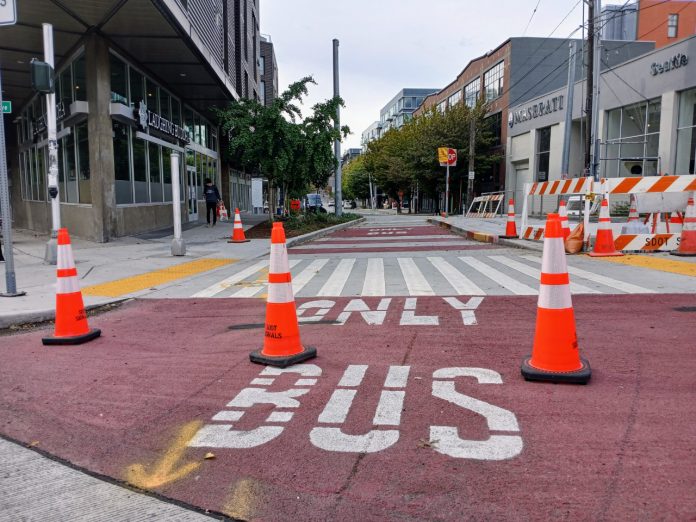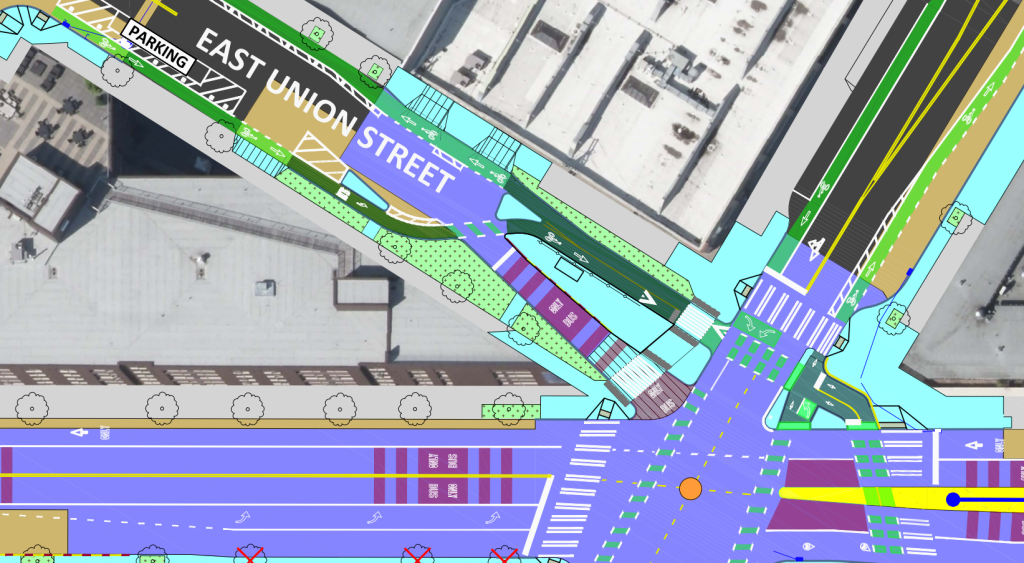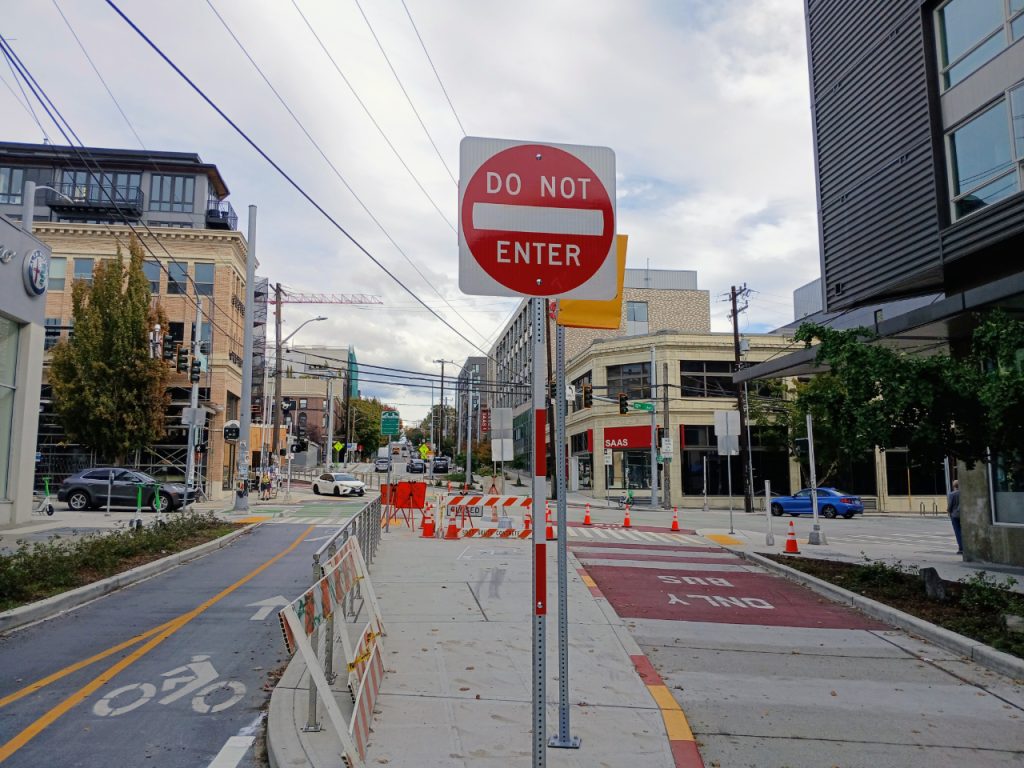
This weekend, Seattle Department of Transportation (SDOT) crews will pivot from installing bike lane barriers or installing speed cushions to something more destructive: removing a bus lane.
The stretch of red paint in question sits on East Union Street just west of 12th Avenue, and was built as part of the $144 million RapidRide G project, which overhauled the Madison Street corridor and paved the way for thousands of new daily transit trips throughout Downtown, First Hill, Capitol Hill, and Madison Valley. Rather than the new RapidRide vehicles, this bus lane was built for the Route 2, which travels between Madrona and Upper Queen Anne.
Intended to be a direct connection between East Madison Street and Union Street just for Metro coaches, the bus lane has been sitting unused since the completion of RapidRide construction. With that stretch closed, the Route 2 continues to take a circuitous detour via E Pike Street to ultimately reach First Hill.
Rather than open the bus lane as designed, SDOT will be opening the full block to all westbound traffic, disrupting a local access street where plans called for bus and bike traffic to be prioritized.
Update: SDOT has now backed off plans to reopen the section of street to general purpose traffic following the quick mobilization of transit advocates.

Update: additional reporting by The Urbanist has confirmed that the reason the stop didn’t open in 2024 with the rest of the G Line project was the lack of a pedestrian signal across E Union Street. Without a signal to let people walking know when it’s safe to cross, King County Metro had concerns about bus operators turning right from Madison Street onto Union. But adding a signal doesn’t require reopening the street to general purpose traffic.
In explaining the rationale behind the lane’s planned removal to The Urbanist, the department was open about the fact that it was driven by property owners in the area, not nearby residents or people who frequently use these transit connections. This weekend’s work is likely to take many folks around Capitol Hill by surprise.
“These changes were developed with input from Metro and community stakeholders to balance access for businesses, customers, people biking and walking, and bus service,” SDOT spokesperson Mariam Ali told The Urbanist. “Over the last few months, communications were restarted primarily at the request of Dunn & Hobbes, the owner of the Chophouse property, Hunters Capital, and Madrona Real Estate along with business representatives on 12th Avenue north of Madison Street.”
SDOT’s statement was a striking illustration of the current state of the department under Mayor Bruce Harrell and Interim SDOT Director Adiam Emery. With the duo in charge, SDOT has continued many of the bicycle and transit projects started under previous administrations, while also taking advantage of few opportunities to start new ones. The newly approved Seattle Transportation Levy, while set to spend tens of millions of dollars on transit projects, includes very few accountability measures to ensure those upgrades actually speed up the city’s buses.

Many traffic safety advocates have been pushing for years to get the city to reconsider Capitol Hill’s traffic patterns to better accommodate pedestrian and bike traffic. Nonetheless, the intended beneficiaries of a newly reopened E Union Street are the relatively small number of business patrons who drive to the area. In the statement, SDOT even implicitly acknowledged the drawbacks that could come from the change for nearby residents — but prioritized drivers coming to the neighborhood from across the region.
“While development in the area is meant to maximize the appeal of dense urban living, coming off the impacts of COVID and challenges of major street and sidewalk construction, representatives had specific concerns about customers who drive from the Eastside or neighborhoods like Madison Park and Madrona,” Ali continued. “They are having a hard time getting to their destinations or are confused by the new traffic pattern. After coordinating with Metro on Route 2 bus operations, it seemed reasonable to modify the intersection to signalize the pedestrian crossing per Metro’s request and restore the right-turn from westbound Madison St to Union St for driver access to businesses.”
As part of this work, SDOT will add a new pedestrian signal for those who are crossing E Union Street across the reopened bus lane and bike lane. The department has already reconfigured the intersection at 11th and Union Street so that people on bikes cross the street earlier than planned to avoid conflicts with people driving. This too changes the original design of the G Line project, which underwent years of community outreach.
The one upside? The Route 2 will finally be able to serve the stop on E Union Street directly from Madison Street, without having to detour on every single trip over to E Pike Street. However, with general purpose traffic allowed to enter the block, it’s only a matter of time before drivers block the crosswalk behind a bus loading passengers at the stop.
While SDOT has been preparing to remove this stretch of bus infrastructure, it has also been robustly pushing back on advocacy to speed up buses on the Route 8, which connects Capitol Hill riders with Uptown, South Lake Union, and the Central District. A traffic study completed this year looking at adding a bus-only lane for eastbound buses on Denny Way concluded that the impact to general purpose traffic would be too great — without considering the issue of mode shift and increased ridership on a Route 8 freed from traffic snarls.
To remove a bus lane, apparently, requires less traffic study and public outreach. Will opening up E Union Street to drivers — who can otherwise simply turn at Seneca Street — impact the city’s goal of achieving 28% of trips made citywide on transit by 2044? Certainly it doesn’t help.
What is clear is who currently has the ear of leaders at the Seattle Department of Transportation. It’s not bus riders.
Ryan Packer has been writing for The Urbanist since 2015, and currently reports full-time as Contributing Editor. Their beats are transportation, land use, public space, traffic safety, and obscure community meetings. Packer has also reported for other regional outlets including BikePortland, Seattle Met, and PubliCola. They live in the Capitol Hill neighborhood of Seattle.

